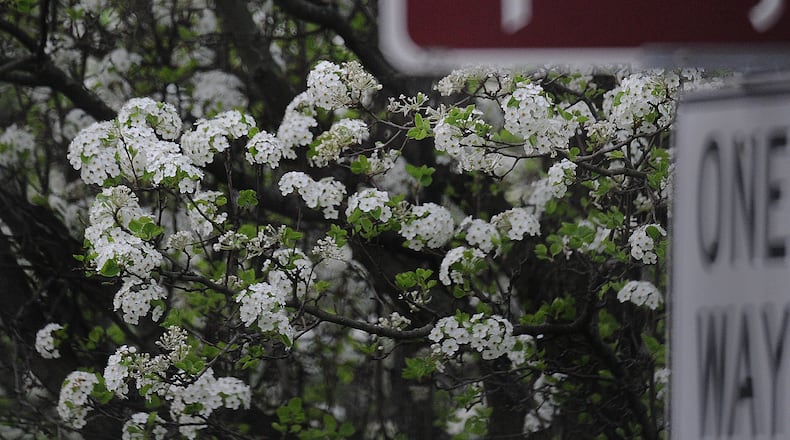“We haven’t really seen any changes,” Brian Huxtable, air pollution control specialist with the Regional Air Pollution Control Agency, said about pollen counts. “Our seasons are typically the same.”
The 2023 Allergy Capitals report uses data from the previous year to rank how challenging it is to live with pollen allergies in the 100 largest cities in the continental United States. The report looks at factors like tree, grass, and weed pollen scores; over-the-counter allergy medicine use, and availability of board-certified allergists/immunologists.
“Last year’s data was better than years previously,” said Dr. Elizabeth L. Barrett of Premier Health Primary Care Beavercreek.
Dayton has been in the top 15 of the worst places in the U.S. for allergies for the past five years. While environmental factors could have impacted allergies, such as if temperatures or rainfall fluctuated, Barrett speculated that the drop on the list was due to other cities getting worse. With temperatures becoming warmer and winters not being as harsh, those factors could be making allergies worse in other regions.
“Generally, our winters across the country are more mild. We’re getting warmer temperatures,” Barrett said.
Since the Asthma and Allergy Foundation of America began generating allergy capitals reports in 2003, seasonal allergies have worsened. A big factor for this is climate change, the foundation said. Climate change has caused the growing seasons to get longer and warmer, leading to higher tree, grass, and weed pollen counts. Some parts of the U.S. now have pollen year-round. The warmer temperatures also get trapped in urban areas, which impact air pollution, the foundation said in its annual report.
No cities in Ohio rank within the top 20 allergy capitals on the foundation’s list. The top 10 include:
1. Wichita, Kan.
2. Dallas, Texas
3. Scranton, Pa.
4. Oklahoma City, Okla.
5. Tulsa, Okla.
6. Sarasota, Fla.
7. Cape Coral, Fla.
8. Orlando, Fla.
9. Des Moines, Iowa
10. Greenville, S.C.
In terms of the types of pollen, Dayton ranks 40th for weed pollen, 79th for grass pollen, and 97th for tree pollen.
Grasses cause most late spring and summer pollen allergy symptoms. It is most common from April through early June, the foundation said. Grass pollen can sometimes be found year-round in warmer parts of the country. It can overlap with tree pollen or weed pollen seasons.
In 2022, Dallas had the highest sum of “high” and “very high” days for tree pollen, according to the foundation. Dayton had the lowest sum of these days. In Dallas, tree pollen was detected as early as December of the previous year and peaked in March and April. In Dayton, tree pollen was detected around February in 2022 and peaked around May.
Allergies in the Dayton region have stayed relatively the same, local experts say. Ragweed season, which happens in the fall, tends to be the worst allergy season, Huxtable said.
“If you are experiencing allergies, it’s important to seek medical advice,” Huxtable said.
Symptoms of allergies include sneezing, runny noses or discharge, itchy eyes, and ears popping or itching. Factors that make outdoor allergies worse include increased rain and increased wind, Barrett said.
For anybody who has allergies, Barrett said they should pay attention to their triggers. Keep your windows closed, and use an air conditioner during warm months. HEPA air purifiers are also designed to help allergy symptoms, Barrett said.
Nonprescription medications can help ease allergy symptoms, such as oral antihistamines, or rinsing your nasal passages with a saline solution with a neti pot bought at your local pharmacy.
“The first line medication is actually your nasal sprays because those are a steroid,” Barrett said. Nasal sprays are more effective in relieving allergy symptoms, Barrett said, and they can also be used in combined treatments.
If you do work outside, such as yard work or gardening, experts recommend taking a shower and changing clothes once you go back inside. Changing your bedsheets frequently also helps with both indoor and outdoor allergies. Hanging clothes up to dry outside can also cause pollen to build up on those clothes, so experts recommend against doing that.
“Keep your windows and doors closed to prevent pollen from getting inside,” Huxtable said. “You can rinse your eyes with saline solution.”
Seasonal allergy signs and symptoms can flare up when there’s a lot of pollen in the air. Apps for your phone like Pollen Wise and Allergy Plus can help people track local pollen levels.
Here is how Dayton has ranked in previous years on the Asthma and Allergy Foundation of America’s annual allergy capitals report:
- 2023―88
- 2022―13
- 2021―15
- 2020―13
- 2019―13
- 2018―7
About the Author

